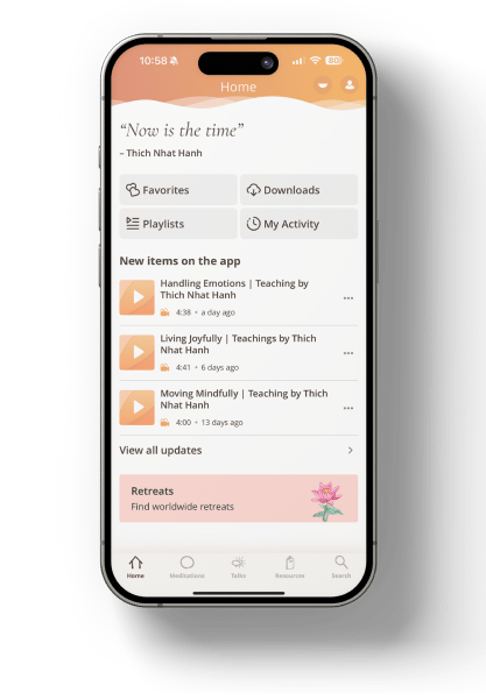The Buddha Is the Sitting
- Let the Buddha breathe, let the Buddha walk, and I don’t need to breathe, I don’t need to walk.
- The Buddha is breathing, the Buddha is walking, and I get to breathe, I get to walk.
- The Buddha is breath, the Buddha is walking, and I am breath, I am walking.
- Only breathing, only walking, no one breathing, no one walking.
- Peace when breathing, joy when walking, peace is breathing, joy is walking.
The practice moves from a seemingly dualistic view to a non-dual view. At first, the Buddha is not me, then the Buddha is a part of me, then the Buddha is me because both the Buddha and I are without self, and finally, the Buddha and I are both the breath and the step that embody peace and joy.
Let the Buddha breathe, let the Buddha walk, and I don’t need to breathe, I don’t need to walk.
We begin with the recognition of the Buddha, of me, of the self, and of walking. Breathing is different, walking is different, the Buddha is different, and I am different; one is outside the other. This is especially true when we are lazy—breathing endlessly, walking endlessly, feeling tired. This is a skillful means. Let the Buddha breathe, let the Buddha walk, and I don’t need to breathe, I don’t need to walk. We can see the Buddha as a part of us, the best part of us. Within us, there are two parts: the lazy part and the Buddha part. Let the Buddha breathe, let the Buddha walk. When we let the Buddha breathe, the Buddha breathes so beautifully. When we let the Buddha walk, the Buddha walks so gracefully. We feel as if we don't need to do anything, and yet we are enjoying the quality of that breath and step.
The Buddha is breathing, the Buddha is walking, and I get to breathe, I get to walk.
These two lines create something very mysterious and very pleasant. The lazy person does nothing, and yet now they enjoy the qualities of the breath and the step. When the Buddha is not breathing, it is as if he is not breathing; when the Buddha breathes, he breathes so beautifully. When the Buddha is not walking, it is as if he is not walking; but when he walks, he walks with peace. We just let the Buddha breathe, let the Buddha walk, and we simply get to enjoy the act of breathing, the act of walking.
The Buddha is breath, the Buddha is walking, and I am breath, I am walking.
By the time we arrive at this third verse, the situation is entirely different. We enter directly into the insight of no-self. How could the Buddha be separate from that miraculous breath? It is through the gentle breath, the serene step, the firm yet peaceful walking that we recognize the Buddha. Beyond that breath, beyond that step, there is no Buddha. The only real thing is the beautiful breath, the solid step. We recognize the presence of the Buddha in that breath, in that step.
After recognizing that I am the breath, I am the step, that there is no "me" outside of the breath and step, we arrive at the affirmation:
Only breathing, only walking, no one breathing, no one walking.
These two lines are very clear and very true to the Buddha’s original teachings. There is only breathing, only walking, with no one breathing, no one walking. There is only the action, without a person, without a self.





